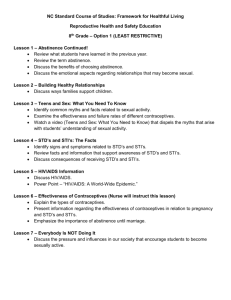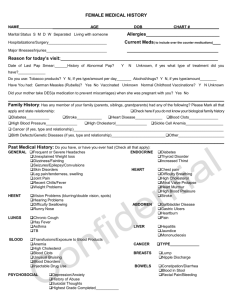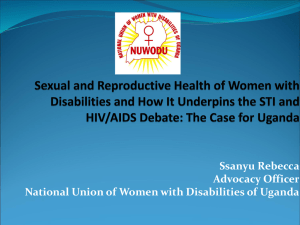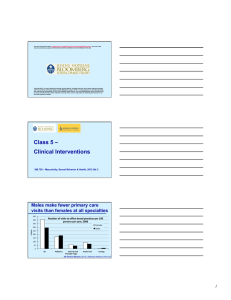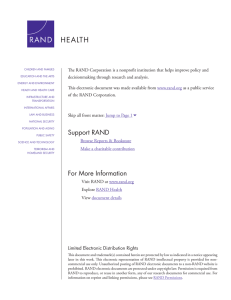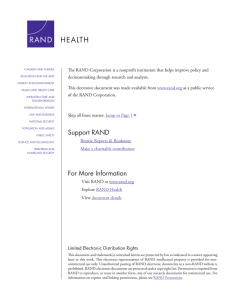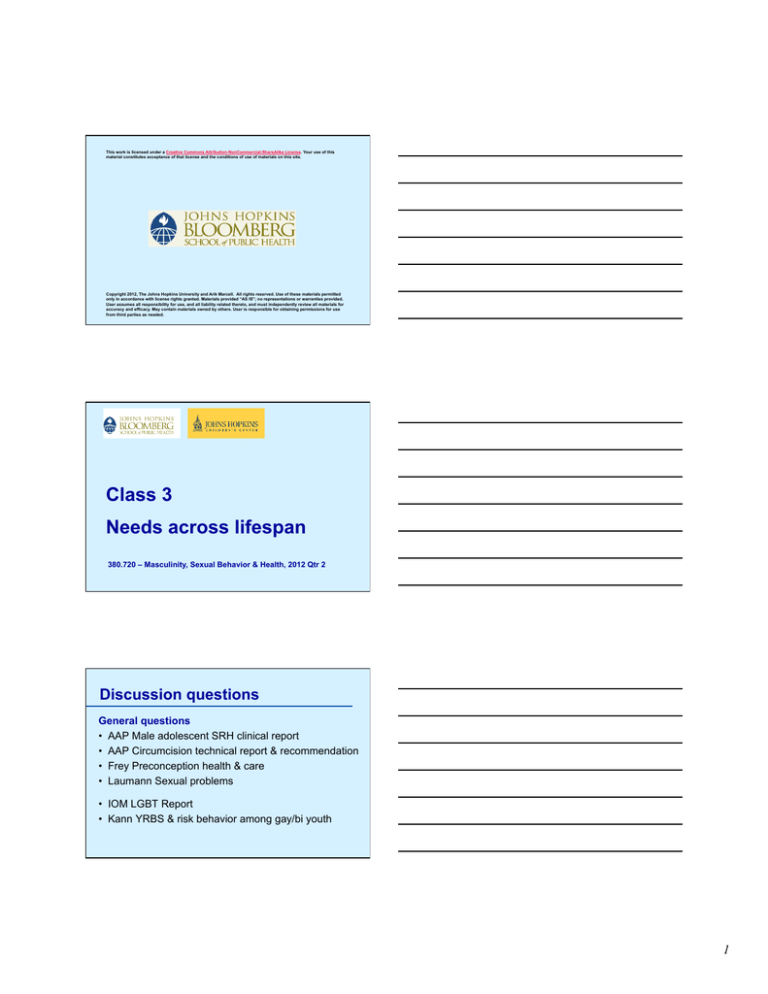
This work is licensed under a Creative Commons Attribution-NonCommercial-ShareAlike License. Your use of this
material constitutes acceptance of that license and the conditions of use of materials on this site.
Copyright 2012, The Johns Hopkins University and Arik Marcell. All rights reserved. Use of these materials permitted
only in accordance with license rights granted. Materials provided “AS IS”; no representations or warranties provided.
User assumes all responsibility for use, and all liability related thereto, and must independently review all materials for
accuracy and efficacy. May contain materials owned by others. User is responsible for obtaining permissions for use
from third parties as needed.
Class 3
Needs across lifespan
380.720 – Masculinity, Sexual Behavior & Health, 2012 Qtr 2
Discussion questions
General questions
• AAP Male adolescent SRH clinical report
• AAP Circumcision technical report & recommendation
• Frey Preconception health & care
• Laumann Sexual problems
• IOM LGBT Report
• Kann YRBS & risk behavior among gay/bi youth
1
Discussion questions
• Healthy People 2020 Objectives
• What do you see as reasons focus on men’s SRH
has been lacking?
Males have multiple SRH needs
National Survey of Adolescent Males Wave 4, 2008-10
- Mean age=37 years (range 35-39 years)
Examined 5 SRH need categories
- In need of family planning
- In need of preconception health
- Have STI risk
- Report sexual problem
- Have fertility concern
%
40
30
16
13
7
Have 1 SRH need
Have 2 or more SRH needs
50 (1 in 2 men)
26 (1 in 4 men)
Marcell et al. In process. 2012.
Multiple SRH needs cont.
Among men with 1 need, majority are in need of
• Family planning OR
• Preconception health
Among men with 2 needs, majority are in need of
• Family planning AND
• STI risk reduction
Among men with 3 or more needs, majority are in
need of
• Family planning,
• Preconception health, AND
• STI risk reduction
Marcell et al. In process. 2012.
2
Discussion questions
• White Paper
– General questions?
– Any feedback given discussion to date?
– Anything missing?
What are the goals of male
sexual & reproductive health (SRH)?
Prevent
1. Unintended pregnancy
2. STIs, including HIV (& control)
3. Reproductive health cancers
Promote
4. Sexual health & development
5. Reproductive life plan &
preconception health
6. Healthy relationships
Reduce
7. Sexual problems, infertility
Increase
8. Lifespan/survival/quality of life
9. Access to care/satisfied w/ care
Child
Teen
+
+
+
+
+
Adult
+
+
+
+
+
+
+ +
+
+
+
+
+
+
+
+
Approaches to Work with Men
Gender neutral
Gender aware
Gender sensitive
•
Take into account gender-specific ways a male may
experience health problems & illness differently than a female
& has capability to effectively communicate with a young man
Gender transformative
•
Work to change societal gender relations (& male culture)
such as helping a young man redefine need to be sexually
promiscuous to prove his manhood & promoting healthy
sexuality
Rao Gupta G. Gender, Sexuality and HIV/AIDS: The What, the WHY
and the How. SIECUS Report 2001;29(5).
3
How should we prioritize needs?
1. Loss of Disability Adjusted Life Years (DALYs)
- Globally, 5.5% of DALYs that adult men lose each year are attributable
HIV/AIDS (WHO, 2004).
- Apart from HIV/AIDS, syphilis is the STI that causes the most global
DALY loss among adult men (WHO, 2004).
- Men under age 50 are rarely affected by reproductive health cancers.
Testicular cancer, which comprises 1.1% of cancers in men, is the most
common cancer affecting young adult men (Garner et al., 2005).
How should we prioritize needs?
2. Disparities in health outcomes
- Adult HIV prevalence ranges from 37.5% in Botswana to less than
0.1% in dozens of countries (WHO, 2004).
- In the US, blacks make up 13% of the population but 39% of those
with AIDS (Stine, 2009).
- Adult incidence of gonorrhea, syphilis, chlamydia, and trichomonas is
2.2% in east Asia and the Pacific, while it is 25.7% in sub-Saharan
Africa (Glasier et al., 2006).
- In Senegal, HIV prevalence is 55 times higher among men who have
sex with men (22%) than among men in the general population (0.4%)
(CRDH, 2005; UNAIDS, 2006).
How should we prioritize needs?
3. Gaps in access to and use of services
- Unmet need for STI screening among men in the US: In 2001, half of
sexually active men in the US between ages 20 and 44 had received no
sexual health care and, of those who did, half received only a testicular
exam (Kalmuss & Austrian, 2009).
- Due to the stigmatization of homosexuality, men who have sex with
men may not disclose to their providers and thus may not receive
appropriate sexual health care (Ryan & Futterman, 1997).
- While unmet need for contraception among men is lower than among
women, it is still extremely high in many developing countries: 42% in
Bangladesh, 36% in Zambia (Becker, 1999).
4
How should we prioritize needs?
4. Relevance to the Millennium Development Goals
a) HIV/AIDS:
- Prevention and treatment for adult men serves Goal 6
directly
b) Family Planning:
- Increasing access and use among men serves Goals 4 and
5 through birth spacing and limiting
- Indirect effects on Goals 1, 2, 3, and 7 as well
5




